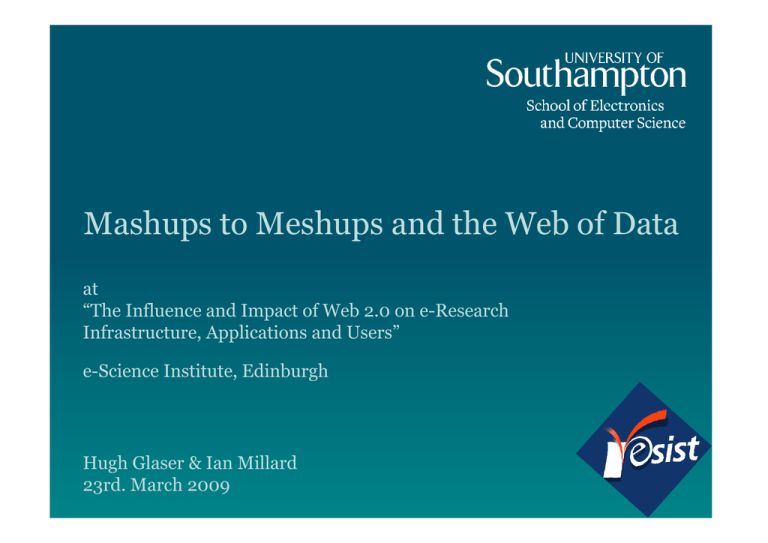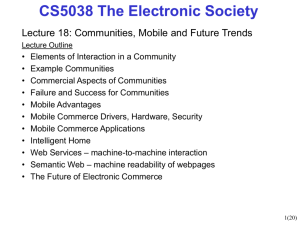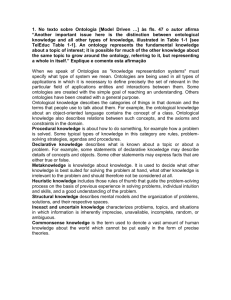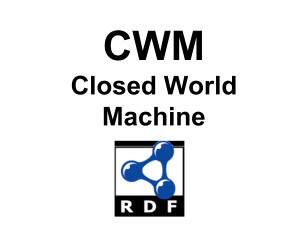Mashups to Meshups and the Web of Data
advertisement

Mashups to Meshups and the Web of Data
at
“The Influence and Impact of Web 2.0 on e-Research
Infrastructure, Applications and Users”
e-Science Institute, Edinburgh
Hugh Glaser & Ian Millard
23rd. March 2009
George Thomas
U.S. government’s recovery.gov
8th March 2009
http://george.thomas.name/omb/recovery.gov.pdf
2
Linked Data
• Tim Berners-Lee
– http://www.w3.org/2009/Talks/0204-ted-tbl/
– “the Semantic Web done right, and the Web done right”
– The Grid and Semantic Web communities are more
separate than they might be (my paraphrase)
• http://esw.w3.org/topic/SweoIG/TaskForces/CommunityProjects/
LinkingOpenData
3
Design Issues - Linked Data
Tim Berners-Lee
Date: 2006-07-27, last change: $Date: 2007/05/02 14:30:56 $
Status: personal view only. Editing status: imperfect but published.
• http://www.w3.org/DesignIssues/LinkedData.html
– Use URIs as names for things
– Use HTTP URIs so that people can look up those names.
– When someone looks up a URI, provide useful information.
– Include links to other URIs. so that they can discover more things.
– Compare language & civilisation:
•
•
•
•
Names & Words (URIs)
Speech (HTTP)
Descriptions (Resolve)
Agreement (Links)
4
How to Publish Linked Data on the Web
• http://www4.wiwiss.fu-berlin.de/bizer/pub/
LinkedDataTutorial/
– The basic tenets of Linked Data are to:
1. Use the RDF Models to publish structured data on the
Web
2. Use RDF links to interlink data from different data
sources
5
RDF
• <subject-uri> <predicate-uri> <object-uri>
or
• <subject-uri> <predicate-uri> “String”
• Eg
@prefix rdf: <http://www.w3.org/1999/02/22-rdf-syntax-ns#> .
@prefix rdfs: <http://www.w3.org/2000/01/rdf-schema#> .
<http://resex.rkbexplorer.com/id/resilience-concept-de7f20d5> rdf:type <http://resex.rkbexplorer.com/ontologies/
resex#Resilience-Concept> .
<http://resex.rkbexplorer.com/id/resilience-concept-de7f20d5> rdfs:label "UML model" .
<http://resex.rkbexplorer.com/id/resilience-concept-de7f20d5> <http://resex.rkbexplorer.com/ontologies/resex#hasdescription> "The UML modeling language describes the system architecture and behaviour in a standard way." .
6
7
Context
• CSAKTiveSpace
– AKT Project
– First Semantic Web
Challenge winner
2003
• ReSIST - EU Network of Excellence in Resilient Systems
– Knowledge-enabled infrastructure
– Jan 2006 – Dec 2008
8
We are pleased to acknowledge the help
and work provided by our ReSIST Partners
and many others.
This work was supported by the ReSIST
Network of Excellence, which is sponsored
by the Information Society Technology (IST)
priority under contract number IST 4
026764 NOE.
Some Underlying Sources
acm.rkbexplorer.com
budapest.rkbexplorer.com
citeseer.rkbexplorer.com
cordis.rkbexplorer.com
courseware.rkbexplorer.com
darmstadt.rkbexplorer.com
dblp.rkbexplorer.com
dbpedia.org
deepblue.rkbexplorer.com
deploy.rkbexplorer.com
epsrc.rkbexplorer.com
eurecom.rkbexplorer.com
ft.rkbexplorer.com
ibm.rkbexplorer.com
ieee.rkbexplorer.com
irit.rkbexplorer.com
italy.rkbexplorer.com
kaunas.rkbexplorer.com
kisti.rkbexplorer.com
laas.rkbexplorer.com
lisbon.rkbexplorer.com
newcastle.rkbexplorer.com
nsf.rkbexplorer.com
pisa.rkbexplorer.com
rae2001.rkbexplorer.com
resex.rkbexplorer.com
roma.rkbexplorer.com
southampton.rkbexplorer.com
ulm.rkbexplorer.com
unlocode.rkbexplorer.com
wiki.rkbexplorer.com
xxx.yyy.zzz
Range from a few 100 to more than 10,000,000 “facts”
For example
• Statistics for repository kisti.rkbexplorer.com
– Last data assertion 2008-09-18 17:16:41
– Number of triples 12815162
– Number of symbols 3239105
– Size of RDF dataset 671M
11
Demo
• RKBExplorer.com
– wiki/dbpedia (Wendy Hall)
• Other components
• Openness
– http://www.rkbexplorer.com/demos/
13
Co-Reference
• Co-Reference is a Big Problem
– Identifying multiple URIs for one resource
– Rejecting incorrectly conflated resources
– Publishing
– Using
• Coldstart
– A serious problem
– Nothing is linked to anything
14
Co-Reference Closure
15
CRS – Consistent Reference Service
• A service to manage and publish co-referent information
• Identify co-referent pairs using a set of tools
• Assert into the CRS
• Query the CRS
– URIi -> { URI1, …, URIi, …, URIn }
• Recommend a Canon
16
CRS continued
• CRS Policies are defined by context
– Often one per Triplestore
– Can be many per Triplestore for different purposes
– May not be associated with a particular Triplestore
• Maintenance
– Provenance
– Rollback
• Can be used to infer owl:sameAs
17
Terms
• Web 2.0
• Web
• Semantic Web
• Linked Data
• Web 3.0
18
Concluding Remarks
• Major Data Fusion using Semantic Web Technologies
• Many things can be cast in a Semantic Web framework
• Linked Data works pretty well
• RDF works pretty well
• A little Ontology goes a long way
• Co-Reference is the biggest problem
– But is tractable
19
• Command economies
– China
• Drilling down to the science
• Enabling linking
– Korea
• Enabling the citizen
20
RKBExplorer.com – Try it!
Supplementary Slides
• Give a sense of the Demo
– (In case the Demo fails)
• Extra Material for questions, etc.
22
Focusing on a Person
Why do you think that?
Where is it Taught?
Communication
• Ontologies
– General Scientific Endeavour
– Domain-specific
– Support (geospatial, etc)
• Open Local Knowledge – HTTP
– Resolvable URIs
– SPARQL
• Uses Remote Knowledge
– Resolves URIs with caching
32
Components 1
• Semantic Web infrastructure throughout
• Triplestore for each source
– Putting the Web in Semantic Web
– Stores RDF – (Subject, Predicate, Object)
– We use 3store
• Linked Data
– 303 and content negotiation architecture with caching
33
Components 2
• Co-Reference Subsystem
– CRS – more later
• Community of Practice Analysis
– Why do you think that?
• Ontology Mapping
– Dealing with other Ontologies
• NLP for text classification
• Caching everywhere
34
Components 3
• Application Middleware
– URI Equivalence Closure
– RDF Graph Closure
• Semantic Sitemap
– Facilitate Search Engines
35
User Interaction
• Semantic MediaWiki
• Custom form interfaces
• Google Maps
• Raw Knowledge Browser
• RKBExplorer
• Why do you think that? information
36
Knowledge Sources
• Partners
• Publications
• Funding Agencies
• Project Wiki
• Courseware
• Resilient-Explicit Computing
• Wide range, don’t just look where you expect to find
37
Dealing With Non-SPARQL KBs
• The RKBExplorer application uses SPARQL to query the
KBs
– But needs to access data from KBs that only offer
resolvable URIs
• So resolve such a URI
• Cache the RDF with associated resolved RDF locally
• Query the local cache
38
Dealing With Different Ontologies
• The RKBExplorer application uses a particular ontology
– Some KBs will use different ontologies
– Eg kisti.rkbexplorer.com
• One solution
– Represent the ontology relationship in RDF (as far as
possible)
– Resolve the URI through the mapping service to get
RDF in the required ontology
39
Supporting resilience
– People, Publication, Projects, Research Areas
– Resilience-related topics
– Resilience-Explicit Computing
– Educational Resources
– In the future
• Automating discovery of issues and solutions
– Design time
– Run time
Finding mechanisms that are appropriate for
Hardware and Aerospace
SELECT DISTINCT ?mechanismURI ?mechanismName ?metadataName ?metadataValue WHERE {
?mechanismURI rdf:type resex:Resilience-Mechanism .
?mechanismURI resex:applies-to-technology akt:Hardware-Platform .
?mechanismURI resex:has-application-domain acm:J.2.0 .
?mechanismURI rdfs:label ?mechanismName .
}
Inspecting metadata, number of variants
SELECT DISTINCT ?mechanismURI ?mechanismName ?metadataName ?metadataValue WHERE {
?mechanismURI rdf:type resex:Resilience-Mechanism .
?mechanismURI resex:applies-to-technology akt:Hardware-Platform .
?mechanismURI resex:has-application-domain acm:J.2.0 .
?mechanismURI rdfs:label ?mechanismName .
?mechanismURI resex:has-resilience-metadata ?metadata .
?metadata resex:metadata-type id:resilience-metadata-type-231c8583
?metadata resex:metadata-type ?mt . ?mt rdfs:label ?metadataName .
?metadata resex:has-value ?metadataValue
}
Inspecting metadata, average cost of implementing fault tolerant
system -vs- cost of implementing non fault tolerant system
SELECT DISTINCT ?mechanismURI ?mechanismName ?metadataName ?metadataValue WHERE {
?mechanismURI rdf:type resex:Resilience-Mechanism .
?mechanismURI resex:applies-to-technology akt:Hardware-Platform .
?mechanismURI resex:has-application-domain acm:J.2.0 .
?mechanismURI rdfs:label ?mechanismName .
?mechanismURI resex:has-resilience-metadata ?metadata .
?metadata resex:metadata-type id:resilience-metadata-type-de1eddf9 .
?metadata resex:metadata-type ?mt . ?mt rdfs:label ?metadataName .
?metadata resex:has-value ?metadataValue
}
Comparison of the operational overheads in
determining a fault has occurred
SELECT DISTINCT ?mechanismURI ?mechanismName ?metadataName ?metadataValue WHERE {
?mechanismURI rdf:type resex:Resilience-Mechanism .
?mechanismURI resex:applies-to-technology akt:Hardware-Platform .
?mechanismURI resex:has-application-domain acm:J.2.0 .
?mechanismURI rdfs:label ?mechanismName .
?mechanismURI resex:has-resilience-metadata ?metadata .
?metadata resex:metadata-type id:resilience-metadata-type-3443934c .
?metadata resex:metadata-type ?mt . ?mt rdfs:label ?metadataName .
?metadata resex:has-value ?metadataValue
}






